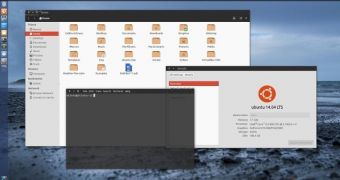Linux users have access to a huge number of desktop environments and all of them are supposed to provide something that the others can't. Some are all about bling and others are strictly about function, but there is a thin slice in the middle with a few DEs that manage to do both. You may not like it, but Unity is one of them.
Before getting too worked up and angry about how I'm making a mistake saying that Unity is actually one of the friendliest desktop environments from an usability point of view, you have to remember that this is just my opinion and nothing more.
Having been able to test such a wide array of solutions, I found out that Unity, despite its shortcomings, is actually the most productive desktop around. I'm not saying the prettiest, the most configurable, the easiest to learn, just that it's the only one that allows me to work unhindered and fast.
Most people don't actually realize that productivity is a very important factor when we talk about desktop environments, but that is not immediately felt by regular users. If you only use an operating system, like most of the people, to check email, surf the web, do a little office work, and maybe play a game, then productivity shouldn't be an issue. You will do just fine with any of the major DEs that are available.
Right now I'm using Linux Mint 17 after a few months of Ubuntu 14.04 LTS, and I have to say that I'm struggling. This is not the first time that I used Cinnamon and I even installed it in Ubuntu a few times, but it gets in the way when trying to do a lot things and fast. It has poor management of multiple desktops, placing application shortcuts in the bottom panel is cumbersome, and it takes a lot of my precious time.
It doesn't stack multiple windows of the same application by default; the start menu is nice, but it's confusing and unusable, although the search field is a plus. To top it all off, the show desktop button is in the wrong place and I hit it all the time by mistake.
Most of the issues I just discussed shouldn't be a problem if you are not in a hurry to do your job but, productivity-wise, the desktop is a mess.
Let’s talk about GNOME for a little bit. Surprisingly, this is much easier to work with, but only after you wasted some time getting it right. The launcher icons are way too big, you can't really interact with the desktop, and you need to install lots of extensions just to make it work the way it should.
KDE, just like Cinnamon, is a mess. Sure enough, it's pretty and the new Plasma 5 desktop might redeem some of the sins from the old generation, but it still shares some of the same issues. The desktop itself needs to be configured, as you can't work with it in the default state (Kubuntu, for example).
For some strange reason, the KDE developers insist on keeping the one-click policy, so you end up opening folders or files all the time, even if you just wanted to select them. The multiple desktops option is not bad, but it still feels strange to move between them. There are way too many categories in Dolphin and it's cluttered like crazy.
These are just a few of the major desktops out there. MATE has some of the same problems, Xfce is light but it's not far from all the others, and I'm not even going to touch something like Enlightenment, which might be a pretty and interesting solution, but it's a nightmare on the long run.
On the other hand, when I use Unity, I don't really need to do anything extra. I just resize those huge icons from the launcher, remove the ones I don't want, and I'm good to go. The multiple desktops feature is a pleasure to work with (although it's not enabled by default), and everything seems to be much smoother.
I don't know if this is the result of some research done by Canonical in usability but, when it comes to productivity, Unity simply works.

 14 DAY TRIAL //
14 DAY TRIAL //